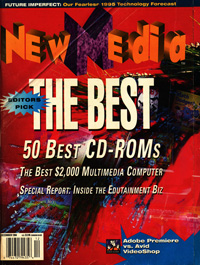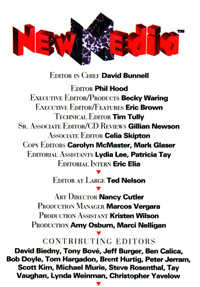|
Vaughan Family Timestream® Maps |
| Home Biography People Places Multimedia: Making It Work On the Water Writings/Presentations |
Ask the Captain
February, 1994
From "Ask the Captain," a monthly column by Tay Vaughan.
New Media Magazine.
Q. Dear Captain: We make multimedia projects for both Macs and PCs using Macromedia Director, Passport Producer, Asymetric's ToolBook, and Microsoft's Visual Basic. A client has sent us about 80 images to incorporate into a presentation, but they are in Quark Express format, and we can't import them into any of our authoring systems. We don't own a copy of Quark, and wonder if there is special translation software we can use to import Quark files?
--Jane Dumont, St. Paul, MN
A. Most software applications save files in a format "native" to the application. Vendors claim that these special formats optimize the file sizes and hard disk write and retrieve speeds for their software. Many word processors, spreadsheets, and drawing programs will, however, read files that have been saved using other manufacturers' proprietary formats, "importing" them through a built-in translator.
When working with images, you typically store picture information as a bitmap (where the size and color attributes of each pixel are described), or as a vector-drawn graphic object (where the picture is composed of one or more mathematically-described objects such as rectangles, ellipses, curves, and even bitmaps and text used as objects). For bitmaps, the most commonly-used "universal" format (for files that can be read by most applications) are PICT on the Mac and TIFF on the PC. For vector-drawn object files, Encapsulated PostScript (EPS) is the most universal file format, although PICT files on the Mac can contain both types of information. There are dedicated programs designed to convert almost any bitmap image file format ever conceived to another format (for the Mac, try DeBabelizer from Equilibrium at 415-332-4343); for the PC, try Image Alchemy from HandMade at 510-252-0101). I haven't discovered similar "Rosetta stone" programs that specialize in translating vector-based drawing formats.
In most multimedia authoring systems, there are no import translators for Quark's proprietary file format. Quark Express (from Quark, Inc. at 800-788-7835) is a popular page layout program used for desktop publishing (DTP) on both Windows and Mac platforms. Greg Morton of Quark recommends that you ask your client to open the image files using Quark, then re-save or "export" them in a format readable by the authoring system you are using (such as PICT or TIFF). Otherwise, you will need to acquire a copy of Quark and do the exporting yourself. Most developers, by the way, use an image editing program such as Photoshop or Photostyler to resize and clean up DTP images before they import them into a multimedia project.
---
Captain's Log: "Edutainment" is a term loosely and widely used in the multimedia community to describe titles and applications that teach and entertain at the same time. However, it seems that this term has been registered as a trademark of Colorado-based LaserLand Corporation, and at least five other companies have also applied to register the term, including Austin Computers for their interactive multimedia books, Creative Technology, Ltd. for their Sound Blaster Edutainment CDs, and Animal Edutainment, Inc. for educational services that use live animals. Who's to say what the holder(s) of this mark may do? If it works like it did for CocaCola®, when the food and beverage industry took the "generic" second half of the term, we could soon be categorizing some multimedia titles as 'tainment. I can't wait to see animatainment, refertainment, infotainment, and even sexatainment products emerge from creative marketing sessions!
---
Q. Dear Captain: Our next CD-ROM title calls for the display of a map of the world in which each continent is a hot button that calls up additional state-specific information. Can I just scan in any map or is there a copyright procedure I need to go through? Where do you go to get maps?
--Janet Brownlie, San Diego, CA
A. Ahh! A good, simple question that disguises much complexity. First of all, you can't just scan someone's artwork and sell it or use it in a multimedia product unless it is in the public domain; it's against copyright laws, but you probably already know that. It is, however, usually OK to use public domain images and maps from sources such as U.S. Geological Survey (USGS), National Oceanic and Atmospheric Administration (NOAA), NASA, and other public agencies. You should know, too, that map sellers traditionally add bogus places and artifacts to their works to identify infringers, as do lexicographers when they add false words to their dictionaries. You can get caught!
The best-selling "Global Explorer" CD-ROM from DeLorme Mapping (207-865-1234), for example, is not only copyrighted, but patented, and the license agreement clearly states "You have not been granted any right to publicly display, reproduce, or distribute any screen image or data generated by the System."
What nobody knows, and what makes your question complicated, lies in the gray area where many multimedia and graphic artists live. Say you find the perfect map in an atlas, scan it into your image editing program, and then remove the text and change all the colors. Maybe you stretch or rotate the image. How much do you need to change so that you can use it as your own?
Most professionals play it safe. For example, Jonathan Gibson, author of the "Wrapture" series of CD-ROM clip art (415-664-4010) says "For our Terra and Luna relief maps, we basically redrew all of the images ourselves from composites." Most likely, the vexing "altered pixel" issue will be someday litigated in the courts; as you would doubtless prefer someone else to provide testimony in that trial, you must remain, for now, in the gray.
Possibly the most comprehensive collection of clip-art maps for multimedia use is provided on a fully-loaded CD-ROM titled "Small Blue Planet: The Real Picture Atlas" from NowWhat Software (800-322-1954). This $79.95 disc contains more than 400 continental mosaics and relief maps, aerial and satellite photographs, and political maps of both the world and the United States rendered to 8-bit color palettes; the World Political Map is current to March, 1993. Additional software support offers zooming and export clipping functions.
---
Send your questions to TAY c/o NewMedia, 901 Mariner's Island Blvd., Suite 365, San Mateo, Calif. 94404 or send a fax to (415) 573-5131. Writers of published questions will receive a NewMedia T-shirt and prompt answers to their questions. Tay is president of Timestream, Inc,. a CD-ROM and multimedia title production and publishing company, and is author of Multimedia: Making It Work, (Osborne/McGraw-Hill).

